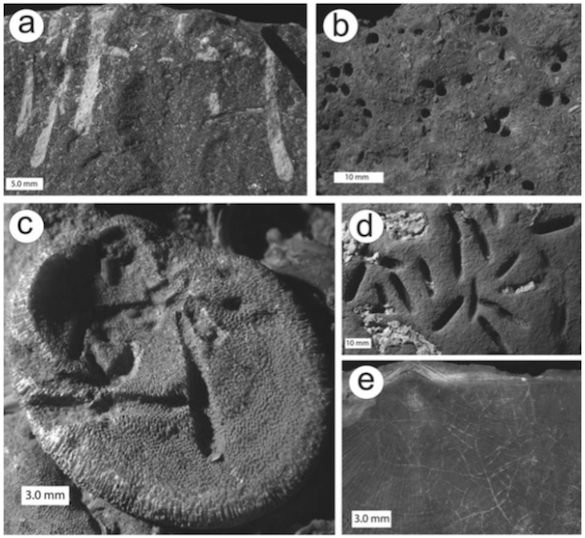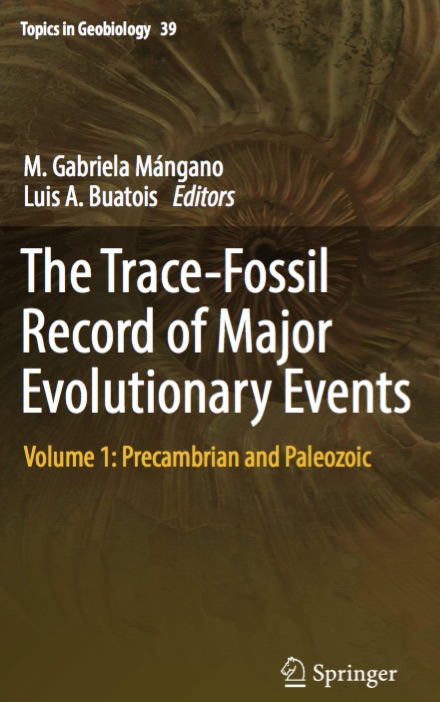 Last semester the Invertebrate Paleontology class at Wooster had its annual field trip into the Upper Ordovician of southern Ohio. We had a great, if a bit muddy, time collecting fossils for each student’s semester-long project preparing, identifying, and interpreting their specimens. Like all research, especially when it starts in the field, there were discoveries and surprises. I always highlight a particular specimen collecting by a student in this blog.
Last semester the Invertebrate Paleontology class at Wooster had its annual field trip into the Upper Ordovician of southern Ohio. We had a great, if a bit muddy, time collecting fossils for each student’s semester-long project preparing, identifying, and interpreting their specimens. Like all research, especially when it starts in the field, there were discoveries and surprises. I always highlight a particular specimen collecting by a student in this blog.
Above is a cross-section of a specimen found by Tommy Peterson (’19). It is the rhynchonellid brachiopod Hiscobeccus capax almost completely enveloped by an encrusting trepostome bryozoan. We’ve cut through the center of the brachiopod, revealing gray micritic sediment and clear calcite crystals. We can infer from this simple specimen that the brachiopod died and its shell remained articulated. Sediment drifted in, filling the bottom half of the shell. The bryozoan eventually sealed it all up as it used the brachiopod shell for a hard substrate on a muddy seafloor. The remaining void space was filled in by the precipitation of calcite crystals. You can see that the crystals nucleated from the outer margin of the cavity and grew inwards, a kind of calcareous geode. I’m intrigued by the irregular sediment surface and the manner in which calcite nucleated upwards from it. I suspect this sediment was itself cemented before the calcite crystals appeared.
This kind of structure is called a geopetal. It shows the “way up” at the time of crystal formation. Gravity held the pocket of sediment in the bottom of the shell, leaving the void at the top. Nice little specimen.
 This star-studded bryozoan found by Alexis Lanier (’20) was going to be the Fossil of the Week, but then I saw that last year I highlighted the very same species! I think the bryozoan Constellaria is cool. Read all about it and its history at the link.
This star-studded bryozoan found by Alexis Lanier (’20) was going to be the Fossil of the Week, but then I saw that last year I highlighted the very same species! I think the bryozoan Constellaria is cool. Read all about it and its history at the link.
 Here are the completed specimen trays for half the class. (Grading this project took, as you might imagine, considerable time!). Every week in lab, after we had done the assigned work, we got out the trays and cleaned, prepared, and identified the specimens. Students learned how to use the rock saws and make acetate peels of the bryozoans and corals.
Here are the completed specimen trays for half the class. (Grading this project took, as you might imagine, considerable time!). Every week in lab, after we had done the assigned work, we got out the trays and cleaned, prepared, and identified the specimens. Students learned how to use the rock saws and make acetate peels of the bryozoans and corals.
 Inside a typical tray. We are very grateful for the many online sources to aid identification of these Cincinnatian fossils. Three in particular were most valuable: Alycia Stigall’s Digital Atlas of Ordovician Life, Steve Holland’s stratigraphic and paleontological guide to the Cincinnatian, and the spectacular Dry Dredgers website.
Inside a typical tray. We are very grateful for the many online sources to aid identification of these Cincinnatian fossils. Three in particular were most valuable: Alycia Stigall’s Digital Atlas of Ordovician Life, Steve Holland’s stratigraphic and paleontological guide to the Cincinnatian, and the spectacular Dry Dredgers website.
Ohio is a paleontological paradise!














































